外研版(2019)选择性必修 第三册Unit 6 Nature in words Grammar 课件(共21张)
文档属性
| 名称 | 外研版(2019)选择性必修 第三册Unit 6 Nature in words Grammar 课件(共21张) | 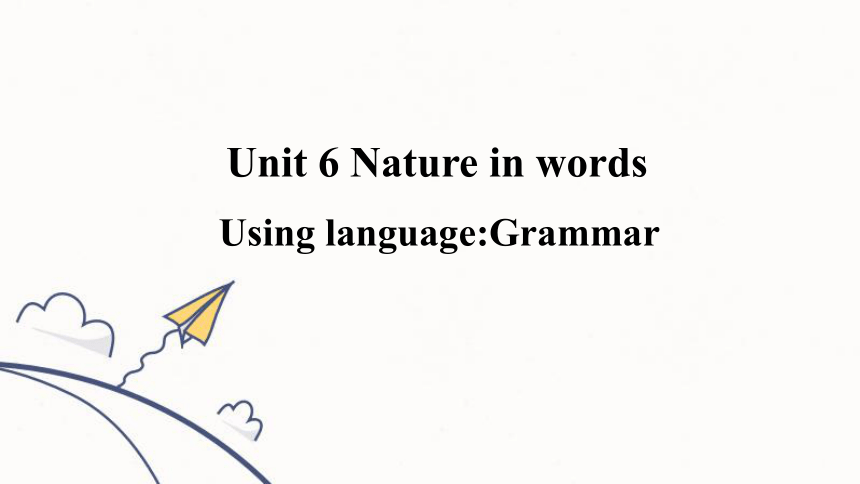 | |
| 格式 | pptx | ||
| 文件大小 | 2.0MB | ||
| 资源类型 | 教案 | ||
| 版本资源 | 外研版(2019) | ||
| 科目 | 英语 | ||
| 更新时间 | 2025-04-26 19:44:47 | ||
图片预览

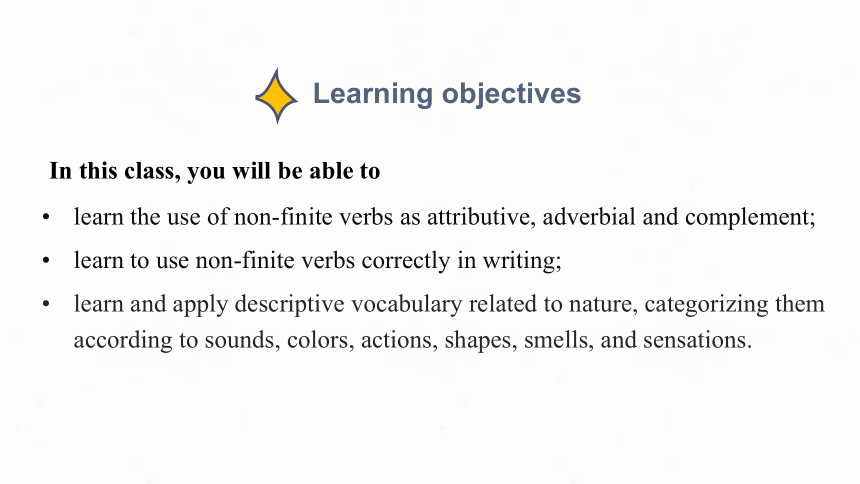
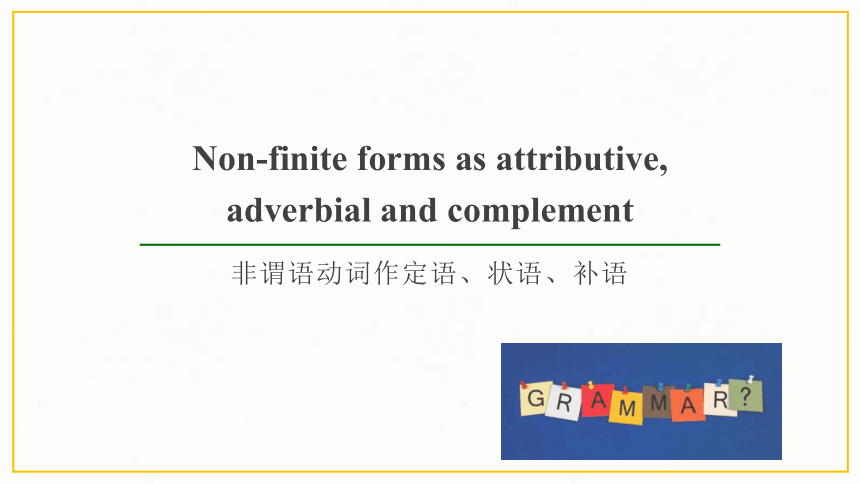
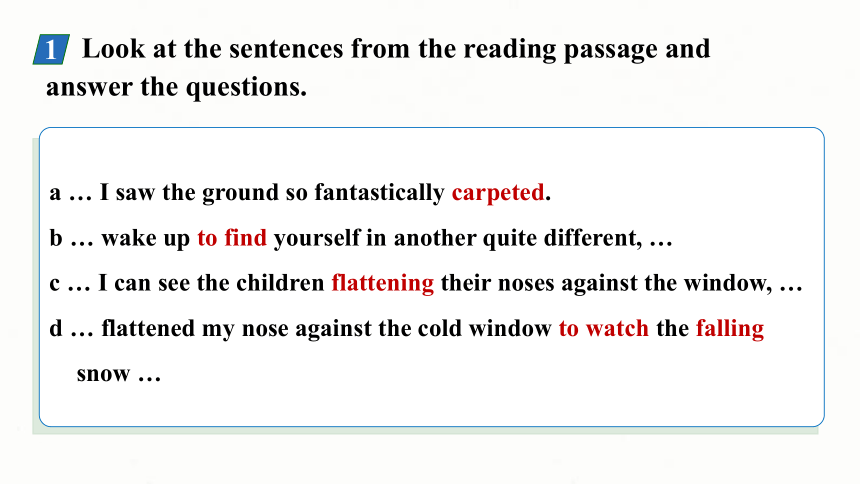
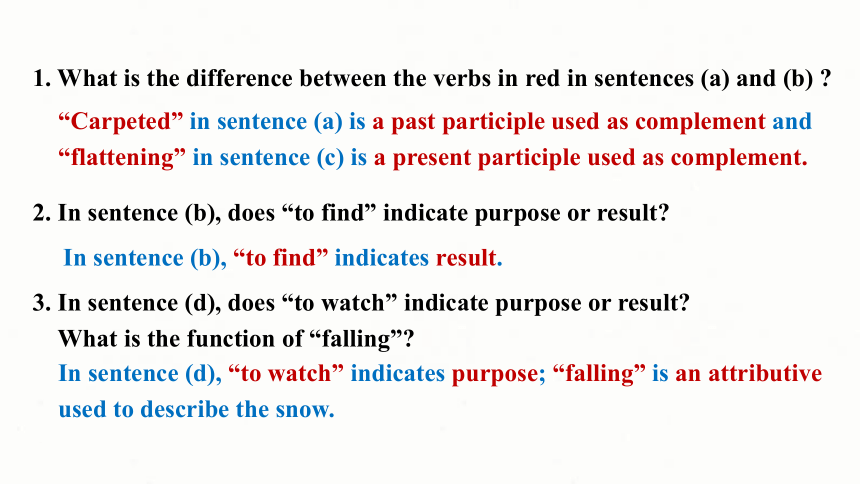
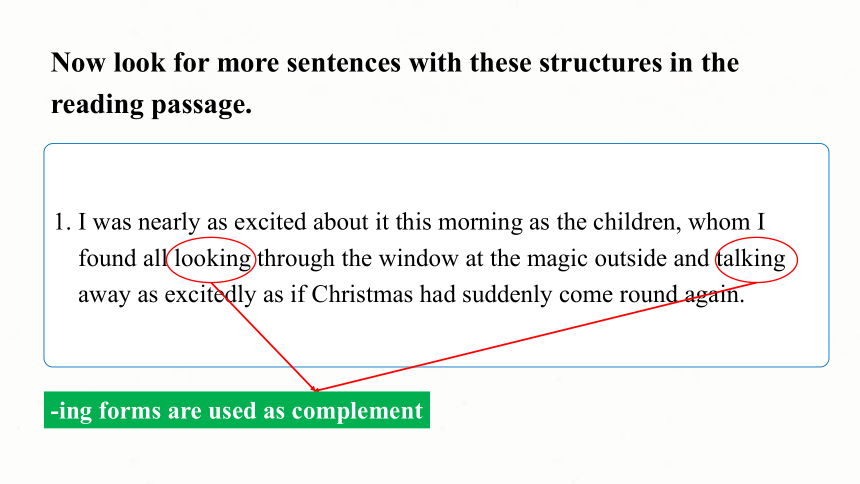
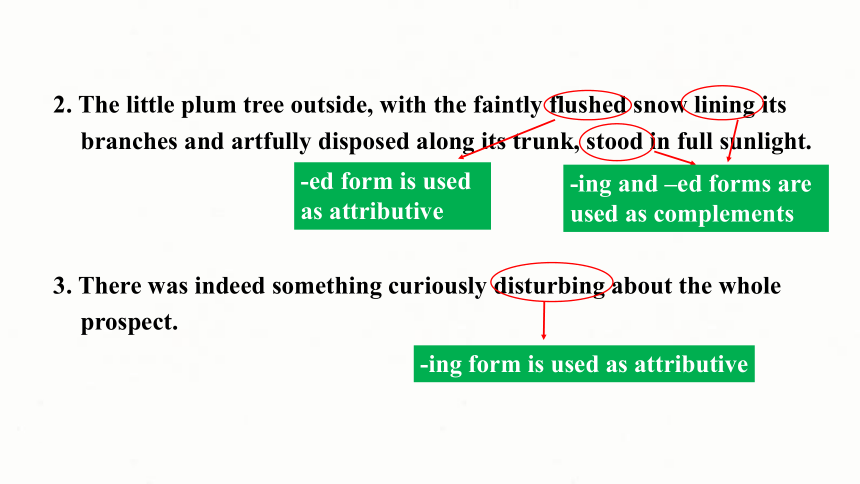
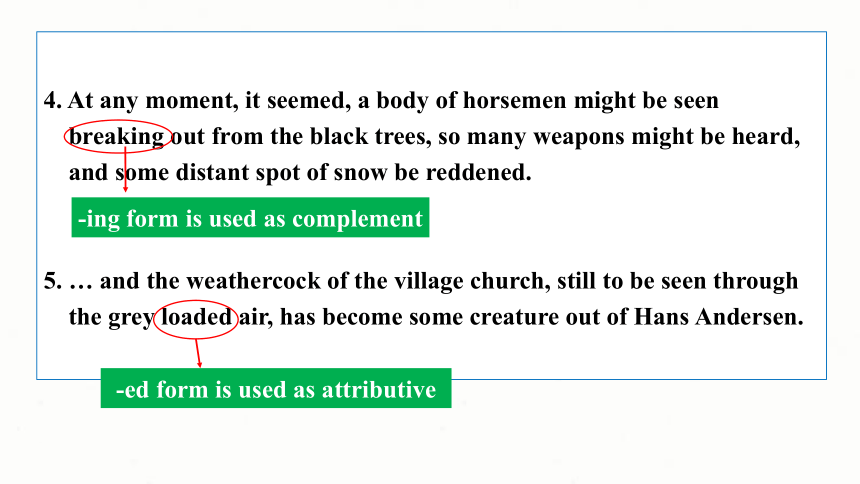
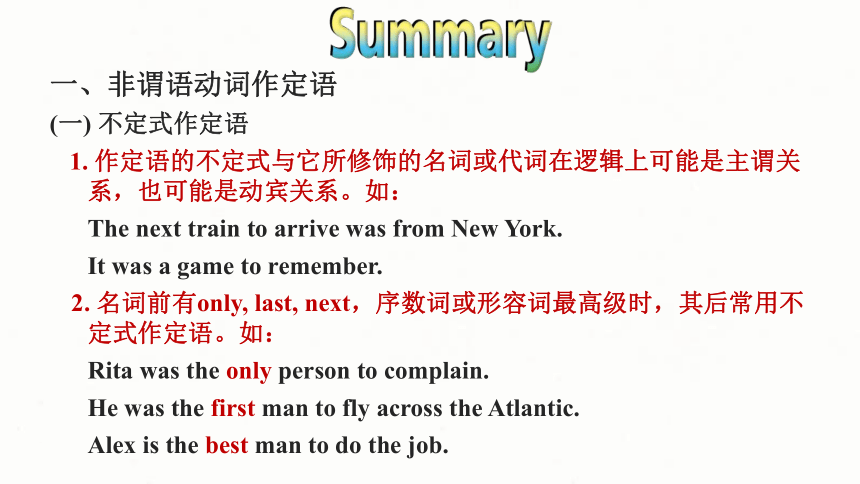
文档简介
(共21张PPT)
Unit 6 Nature in words
Using language:Grammar
learn the use of non-finite verbs as attributive, adverbial and complement;
learn to use non-finite verbs correctly in writing;
learn and apply descriptive vocabulary related to nature, categorizing them according to sounds, colors, actions, shapes, smells, and sensations.
In this class, you will be able to
Learning objectives
Non-finite forms as attributive, adverbial and complement
非谓语动词作定语、状语、补语
Look at the sentences from the reading passage and answer the questions.
a … I saw the ground so fantastically carpeted.
b … wake up to find yourself in another quite different, …
c … I can see the children flattening their noses against the window, …
d … flattened my nose against the cold window to watch the falling snow …
1
1. What is the difference between the verbs in red in sentences (a) and (b)
“Carpeted” in sentence (a) is a past participle used as complement and “flattening” in sentence (c) is a present participle used as complement.
2. In sentence (b), does “to find” indicate purpose or result
In sentence (b), “to find” indicates result.
3. In sentence (d), does “to watch” indicate purpose or result What is the function of “falling”
In sentence (d), “to watch” indicates purpose; “falling” is an attributive used to describe the snow.
1. I was nearly as excited about it this morning as the children, whom I found all looking through the window at the magic outside and talking away as excitedly as if Christmas had suddenly come round again.
Now look for more sentences with these structures in the reading passage.
-ing forms are used as complement
2. The little plum tree outside, with the faintly flushed snow lining its branches and artfully disposed along its trunk, stood in full sunlight.
3. There was indeed something curiously disturbing about the whole prospect.
-ed form is used as attributive
-ing and –ed forms are used as complements
-ing form is used as attributive
4. At any moment, it seemed, a body of horsemen might be seen breaking out from the black trees, so many weapons might be heard, and some distant spot of snow be reddened.
5. … and the weathercock of the village church, still to be seen through the grey loaded air, has become some creature out of Hans Andersen.
-ing form is used as complement
-ed form is used as attributive
一、非谓语动词作定语
(一) 不定式作定语
作定语的不定式与它所修饰的名词或代词在逻辑上可能是主谓关系,也可能是动宾关系。如:
The next train to arrive was from New York.
It was a game to remember.
2. 名词前有only, last, next,序数词或形容词最高级时,其后常用不定式作定语。如:
Rita was the only person to complain.
He was the first man to fly across the Atlantic.
Alex is the best man to do the job.
3. 有些名词的同根动词后常跟不定式,因而这些名词后也常跟不定式作定语。如:
Their offer to assist in the work was not taken seriously.
(二) 动词-ing形式作定语可表示正在进行的动作,也可表示经常发生
的或短暂的动作以及经常存在的状态。如:
The woman sending her children to school is my history teacher.
A little child learning to walk often falls.
(三) 过去分词作定语常表示被动或已经发生的动作。
如: We’ve met the doctors sent to work here by the city hospital.
二、非谓语动词作状语
(一) 不定式作状语,常表示目的、原因、结果等。不定式作结果状语时,常用于“only +不定式”结构,表示未曾预料到的或令人不快的结果。如:
A friend of mine came to see me tonight.
I jumped with joy to hear it.
Alan lifted a rock only to drop it on his own feet.
(二) 动词-ing形式或过去分词作状语时,可以表示时间、原因、结果、条件、让步、方式、伴随情况等,其前可加连词while, when, once, if, unless等。如:
Crossing the street, he was knocked down by a car.
Frightened by the noise outside, the little girl dared not sleep in her bedroom.
He fell off the bike, breaking his left leg.
Seen through the eyes of a young friend, Einstein was a simple, modest and ordinary man.
A group of children were sitting around the teahcer, playing games.
When heated, ice will be changed into water.
三、非谓语动词作补语
1.动词-ing形式表示正在进行的活动或反复的动作,而不定式则表示整个活动或事件的全过程。如:
I see him passing my house every day.
I asked George to convey my best wishes to his mother.
2) 感官动词和使役动词后常接省略to的不定式作宾语补足语,但用于被动语态时,需把to补出来。如:
Someone saw Mary enter the building about the time the crime
was committed.
Mary was seen to enter the building about the time the crime was
committed.
另外,感官动词后也可接动词-ing形式作补语,表示动作正在进行。
如:
Once in the middle of the night I woke and heard the wind blowing.
1. Chinese researchers hope to use the instruments onboard Chang’e-4 ________ (find) and study areas of the South Pole-Aitken basin.
2. The next morning he hired a boat and set out ________ (find) the well-known painter.
…And when he saw the mists rising from the river and the soft clouds ______________ (surround) the mountain tops, he was reduced to tears.
to find
to find
surrounding
3. Chinese New Year is a celebration marking the end of the winter season and the beginning of spring. This is why decorating with plants, fruits and flowers carries special significance. They represent the earth ________ (come) back to life and best wishes for new beginnings.
These are some of the most popular in many parts of the country:
Oranges: Orange trees are more than decoration; they are a symbol of good fortune and wealth. They make great gifts and you see them many times _________ (decorate) with red envelopes and messages of good fortune.
…Bamboo plants are associated with health,
abundance and a happy home. They are easy
_______ (care) for and make great presents.
coming
decorated
to care
4. As well as looking at exhibits, visitors can play with computer simulations (模拟) and imagine themselves living at a different time in history or ________ (walk) through a rainforest.
5. Agriculture gave people their first experience of the power of technology _________ (change) lives.
…Later, they learned to work with the seasons, planting at the right time and in dry areas, _______ (make) use of annual floods to irrigate (灌溉) their fields.
walking
to change
making
Complete the passage with the correct form of the verbs in brackets.
The Lake Poets were a small group of poets 1 _______ (live) in the Lake District of England in the late 18th and early 19th centuries. The Lake District, 2_______ (know) for its beauty, is in the north-west of England. The first of the poets 3________________ (come) there was Robert Southey, one of the most 4____________ (respect) poets of his time. He was followed by William
Wordsworth, perhaps Britain’s most 5___________
living
known
to come/coming
respected
2
celebrated
(celebrate) 19th century poet, and then Samuel Coleridge, who had written the 6_________ (pioneer) work Lyrical Ballads with Wordsworth. Soon, 7________ (draw) both by its natural beauty and a desire to be near these famous poets, other poets came 8_______ (live) in the Lake District. All of these poets were seen as part of the Romantic Movement.
pioneering
drawn
to live
Look at the picture and complete the travel journal entry with the words in the box. Use the structures you have learnt in this unit where appropriate.
find blow go see fall relax enjoy run
Today, whilst walking along a peaceful river running through a university campus, I was amazed to find ... ____________________________________________
_______________________________________________________________
_______________________________________________________________
3
I was amazed to find it is a beautiful public place to walk, picnic, relax and enjoy the view of the river.
On both banks of the river, there are two walking paths going along the river. There are also several long shady spots that make it perfect for a spring stroll.
If you pause long enough here, you’ll undoubtedly see some flowers falling from the peach trees and the willow branches swaying in the wind.
It’s really an unusual sight in an urban area.
Work in pairs. Talk about a travel experience of your own that brought you closer to nature, using the structures you have learnt in this unit where appropriate.
4
Unit 6 Nature in words
Using language:Grammar
learn the use of non-finite verbs as attributive, adverbial and complement;
learn to use non-finite verbs correctly in writing;
learn and apply descriptive vocabulary related to nature, categorizing them according to sounds, colors, actions, shapes, smells, and sensations.
In this class, you will be able to
Learning objectives
Non-finite forms as attributive, adverbial and complement
非谓语动词作定语、状语、补语
Look at the sentences from the reading passage and answer the questions.
a … I saw the ground so fantastically carpeted.
b … wake up to find yourself in another quite different, …
c … I can see the children flattening their noses against the window, …
d … flattened my nose against the cold window to watch the falling snow …
1
1. What is the difference between the verbs in red in sentences (a) and (b)
“Carpeted” in sentence (a) is a past participle used as complement and “flattening” in sentence (c) is a present participle used as complement.
2. In sentence (b), does “to find” indicate purpose or result
In sentence (b), “to find” indicates result.
3. In sentence (d), does “to watch” indicate purpose or result What is the function of “falling”
In sentence (d), “to watch” indicates purpose; “falling” is an attributive used to describe the snow.
1. I was nearly as excited about it this morning as the children, whom I found all looking through the window at the magic outside and talking away as excitedly as if Christmas had suddenly come round again.
Now look for more sentences with these structures in the reading passage.
-ing forms are used as complement
2. The little plum tree outside, with the faintly flushed snow lining its branches and artfully disposed along its trunk, stood in full sunlight.
3. There was indeed something curiously disturbing about the whole prospect.
-ed form is used as attributive
-ing and –ed forms are used as complements
-ing form is used as attributive
4. At any moment, it seemed, a body of horsemen might be seen breaking out from the black trees, so many weapons might be heard, and some distant spot of snow be reddened.
5. … and the weathercock of the village church, still to be seen through the grey loaded air, has become some creature out of Hans Andersen.
-ing form is used as complement
-ed form is used as attributive
一、非谓语动词作定语
(一) 不定式作定语
作定语的不定式与它所修饰的名词或代词在逻辑上可能是主谓关系,也可能是动宾关系。如:
The next train to arrive was from New York.
It was a game to remember.
2. 名词前有only, last, next,序数词或形容词最高级时,其后常用不定式作定语。如:
Rita was the only person to complain.
He was the first man to fly across the Atlantic.
Alex is the best man to do the job.
3. 有些名词的同根动词后常跟不定式,因而这些名词后也常跟不定式作定语。如:
Their offer to assist in the work was not taken seriously.
(二) 动词-ing形式作定语可表示正在进行的动作,也可表示经常发生
的或短暂的动作以及经常存在的状态。如:
The woman sending her children to school is my history teacher.
A little child learning to walk often falls.
(三) 过去分词作定语常表示被动或已经发生的动作。
如: We’ve met the doctors sent to work here by the city hospital.
二、非谓语动词作状语
(一) 不定式作状语,常表示目的、原因、结果等。不定式作结果状语时,常用于“only +不定式”结构,表示未曾预料到的或令人不快的结果。如:
A friend of mine came to see me tonight.
I jumped with joy to hear it.
Alan lifted a rock only to drop it on his own feet.
(二) 动词-ing形式或过去分词作状语时,可以表示时间、原因、结果、条件、让步、方式、伴随情况等,其前可加连词while, when, once, if, unless等。如:
Crossing the street, he was knocked down by a car.
Frightened by the noise outside, the little girl dared not sleep in her bedroom.
He fell off the bike, breaking his left leg.
Seen through the eyes of a young friend, Einstein was a simple, modest and ordinary man.
A group of children were sitting around the teahcer, playing games.
When heated, ice will be changed into water.
三、非谓语动词作补语
1.动词-ing形式表示正在进行的活动或反复的动作,而不定式则表示整个活动或事件的全过程。如:
I see him passing my house every day.
I asked George to convey my best wishes to his mother.
2) 感官动词和使役动词后常接省略to的不定式作宾语补足语,但用于被动语态时,需把to补出来。如:
Someone saw Mary enter the building about the time the crime
was committed.
Mary was seen to enter the building about the time the crime was
committed.
另外,感官动词后也可接动词-ing形式作补语,表示动作正在进行。
如:
Once in the middle of the night I woke and heard the wind blowing.
1. Chinese researchers hope to use the instruments onboard Chang’e-4 ________ (find) and study areas of the South Pole-Aitken basin.
2. The next morning he hired a boat and set out ________ (find) the well-known painter.
…And when he saw the mists rising from the river and the soft clouds ______________ (surround) the mountain tops, he was reduced to tears.
to find
to find
surrounding
3. Chinese New Year is a celebration marking the end of the winter season and the beginning of spring. This is why decorating with plants, fruits and flowers carries special significance. They represent the earth ________ (come) back to life and best wishes for new beginnings.
These are some of the most popular in many parts of the country:
Oranges: Orange trees are more than decoration; they are a symbol of good fortune and wealth. They make great gifts and you see them many times _________ (decorate) with red envelopes and messages of good fortune.
…Bamboo plants are associated with health,
abundance and a happy home. They are easy
_______ (care) for and make great presents.
coming
decorated
to care
4. As well as looking at exhibits, visitors can play with computer simulations (模拟) and imagine themselves living at a different time in history or ________ (walk) through a rainforest.
5. Agriculture gave people their first experience of the power of technology _________ (change) lives.
…Later, they learned to work with the seasons, planting at the right time and in dry areas, _______ (make) use of annual floods to irrigate (灌溉) their fields.
walking
to change
making
Complete the passage with the correct form of the verbs in brackets.
The Lake Poets were a small group of poets 1 _______ (live) in the Lake District of England in the late 18th and early 19th centuries. The Lake District, 2_______ (know) for its beauty, is in the north-west of England. The first of the poets 3________________ (come) there was Robert Southey, one of the most 4____________ (respect) poets of his time. He was followed by William
Wordsworth, perhaps Britain’s most 5___________
living
known
to come/coming
respected
2
celebrated
(celebrate) 19th century poet, and then Samuel Coleridge, who had written the 6_________ (pioneer) work Lyrical Ballads with Wordsworth. Soon, 7________ (draw) both by its natural beauty and a desire to be near these famous poets, other poets came 8_______ (live) in the Lake District. All of these poets were seen as part of the Romantic Movement.
pioneering
drawn
to live
Look at the picture and complete the travel journal entry with the words in the box. Use the structures you have learnt in this unit where appropriate.
find blow go see fall relax enjoy run
Today, whilst walking along a peaceful river running through a university campus, I was amazed to find ... ____________________________________________
_______________________________________________________________
_______________________________________________________________
3
I was amazed to find it is a beautiful public place to walk, picnic, relax and enjoy the view of the river.
On both banks of the river, there are two walking paths going along the river. There are also several long shady spots that make it perfect for a spring stroll.
If you pause long enough here, you’ll undoubtedly see some flowers falling from the peach trees and the willow branches swaying in the wind.
It’s really an unusual sight in an urban area.
Work in pairs. Talk about a travel experience of your own that brought you closer to nature, using the structures you have learnt in this unit where appropriate.
4
